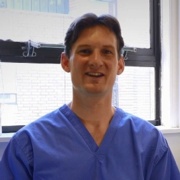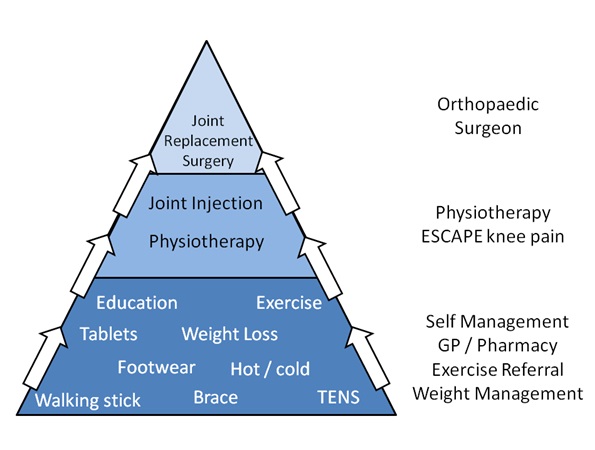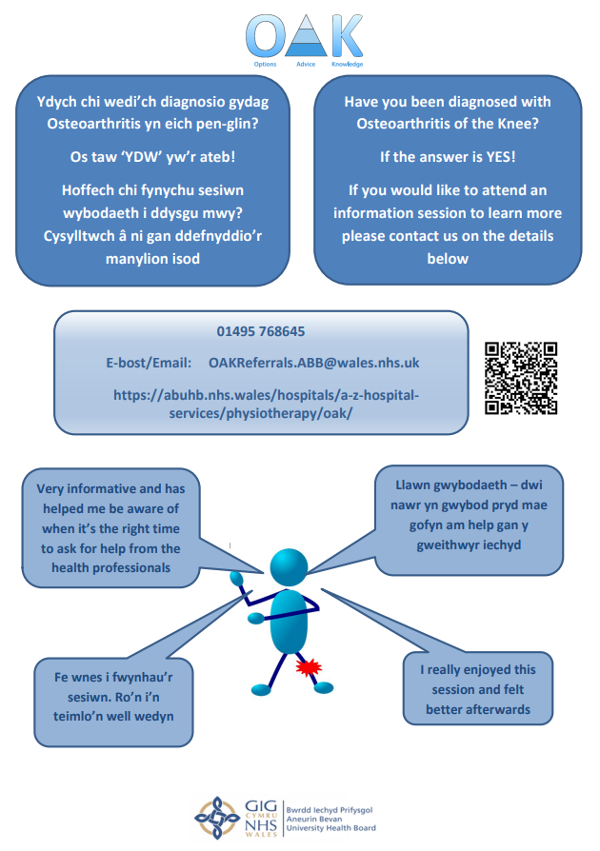What is OAK Knee?
Here at Aneurin Bevan University Health Board we are offering a session called OAK which is dedicated to the management of osteoarthritis of the knee. OAK knee sessions have been developed in collaboration with GP’s, Orthopaedic surgeons, Physiotherapists and people like you, who have osteoarthritis of the knee.

The aim is to achieve a functional bend in the knee so that you are able to stand up and sit down out of a chair and get in and out of a bed before going home.
Activity & Exercise - Mark Hodgson - Video
|
We know that exercise is one of the most powerful tools for helping people to manage osteoarthritis of the knee. However for many people with Osteoarthritis this does not always make sense. It is common to think of the condition as a wear and tear process, and therefore using the knee more seems like a bad idea. However as we showed in the earlier video, OA is a mix of a degenerative and a healing response, many of the tissues get stronger, the bone thickens and widens, the ligaments and capsule thicken. This means that using the knee, strengthening the supporting muscles can actually help the healing element and improve symptoms like pain and stiffness.
We know that simple exercise to strengthen the leg muscle or your heart and lungs leads to a significant and predictable reduction in pain and improvement in ability to do things.
So what do we mean by exercise. Well pretty much anything really. As long as it works your leg muscles or your heart and lungs, or preferably both, it will help your knee pain. It is important to get a balance and little and often is usually the best place to start. Most people who exercise regularly do so because they enjoy it and often because it comes with a social situation or friends that they enjoy spending time with. So it's worth considering these things.
We have put a lot of information on the website about leisure facilities and groups that might help you find something you enjoy.
|
|
|
One option to help you become more confident to exercise is the National Exercise referral Scheme, or NERS for short. This is available throughout Aneurin Bevan Health Board region. It is a community run scheme supported by most council run leisure centres. It provides a variety of activities and exercise types, there really is something for everyone. To access the scheme, you will need a referral from your GP, physio or another healthcare professional. There is also a small cost associated with the programme. A commitment to attend twice a week for 16 weeks would be necessary. More information can be found on the NERS website
Physiotherapy is another option for helping with your OA symptoms. Consider physiotherapists as experts in human movement and how pain or disease can affect this. A physio can assess your knee and how it moves, and make recommendations for how to reduce some of your symptoms. Exactly what options are used will vary depending on the person with OA, and what the physio finds. These options will be discussed with you at the time of your assessment.
Physiotherapists will nearly always recommend the use of exercise to build muscle tissue around the knee and leg. They can help you find the right option for you. Throughout ABUHB we have an exercise class called ESCAPE knee pain. This requires you to attend a 1 hour exercise session twice a week for 6 weeks, so 12 sessions in total. Joining in on these classes has been shown to reduce pain and improve function, not just whilst you are doing it, but for several years afterwards too. ESCAPE knee pain is now available on the ESCAPE website or via a Mobile App.
Some people feel confident to exercise without professional support, and we would absolutely support this. So the decision of how to exercise, on your own, with friends, at NERS or with Physiotherapy is up to you and your preferences. Further information can be found on the Versus Arthritis website
|
Pain is often the primary reason that Osteoarthritis becomes a problem. Pain can often be effectively managed with simple over the counter medications, although a discussion with your GP or pharmacy is important before starting any new medication to ensure it is not harmful for you. There are other options too, heat and cold packs can give relief of pain when applied and a TENS machine can also be applied to the knee as a way of reducing pain without medicines.
The knee is the largest and one of the most complex joints in the human body. During simple activities it withstands large loads as it carries the body’s weight. The knee joint is shaped to withstand these forces and benefits from the support of the body’s largest muscles which share and absorb these loads whilst controlling motion. Within the knee there is a layer of cartilage, white shiny slippery stuff that lines and protects the bone ends. This helps to provide smooth movement and absorb these forces.
Osteoarthritis starts when there is damage to the cartilage. The most common factors which cause this are previous injury, obesity and age. The cartilage gets gradually thinner, less able to shock absorb and protect. The joint does not move as smoothly. The bone is under more stress, however it reacts by growing thicker and broader so that it can still bear the load. The lining of the joint may swell to produce more fluid to try and keep the joint lubricated. The capsule and ligaments can become thickened to try and strengthen the joint. So osteoarthritis is partly a condition of inflammation and partly one of repair. In many cases the repair is reasonably successful and the changes do not cause a great deal of pain or disability.
Osteoarthritis can cause a variety of symptoms, however pain and stiffness are the most common. Pain is usually worse with movement and at the end of the day and typically eases with rest, however the joint often stiffens when not in use.
So now we know what osteoarthritis is, what can be done about it?
Whilst there is currently no cure for Osteoarthritis, there are many treatments that can offer significant relief from the symptoms, helping you to manage the joint and keep it working for you into the future. None of these treatments are able to cure osteoarthritis, however they are all able to relieve pain and stiffness enabling you to do more of what you like.
We cannot say who will respond best to each treatment and so it is up to you to understand what can be done and to decide what you feel would help you, then give it a try and see.

In order to make it onto our pyramid treatments have to have been appropriately tested and shown to work. There are several international clinical guidelines which we have used to create the pyramid, so you can be sure that these are well tested and safe interventions that work for most people.
So, how do you decide what you want to do?
We would like to take you through a process of how you might make that decision. Most people think about how bad the disease or the damage is. We can measure this on an X ray, however the amount of arthritis is not always related to the amount of pain.
There is a far more important indicator. That is the symptoms that you feel, the pain, the swelling, the activities that you are limited in. Only you know this, it is very individual and importantly it is not always related to how much arthritis you have.
So even if you have a bad X ray, if you can control the symptoms using these treatments, you can feel better, have less pain and a better quality of life. That is why they are recommended for everyone to try. It’s never too late to give them a go.
Each of you is individual and should therefore make an individual decision of what is right for you.
Are you someone whose weight might be contributing to increased stress at the knee? We know that just 5% weight loss can reduce pain when walking.
Are you someone whose muscle are not supporting the knee well? We know that strengthening exercise is a powerful way of reducing pain and improving what you can do.
Are you someone who might benefit from wearing different shoes or a knee brace to support and cushion the knee?
Or are you someone who has tried everything and would now benefit from discussing knee replacement with a surgeon?
There is further information about all these options on the website, or come along to an OAK knee session and find out more.
What is Osteoarthritis? - Video
Links to further information about OA Knee |
ExerciseWeight Loss
|
Weight Management - Jonathan Morgan - Video
|
As we work through some of the ways you can influence the symptoms you experience in your knee, we start to look at joint pressure and how pressure can influence your symptoms
When we do simple things like walk or climb stairs, pressure in your knee can reach up to 3 or 4 times your body weight.
Reducing the amount of weight which a knee has to carry does in the majority of patients have a positive influence on their knee symptoms. So, if you are overweight, then weight loss is a very powerful way of reducing stress on the knees and reducing the symptoms of Osteoarthritis for the long term. So we know weight loss is a powerful tool. Research has shown that even small amounts of weight loss can help reduce symptoms. But, we also know weight loss can be a difficult process, so getting the right support is important. Some people start by developing a healthy diet and eating appropriately sized portions. Having support and a weight loss plan can help make weight loss more successful.
More information on this can be found on the NHS website
|
|
|
There are lots of providers of weight management support and we would encourage you to look around in the local community for groups that might be right for you. If you have tried and struggled to lose weight with local support in the past, Aneurin Bevan University health board are able to offer guidance and support to get you on your way via our Weight Management Service.
If you come to the stage where joint replacement is required, those with a healthy weight carry a lower risk and often recover better. |
